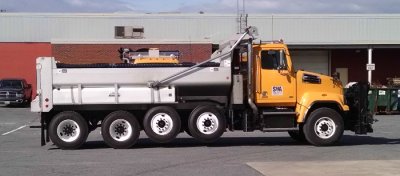
One of Maryland's new quad-axle “Monster Plow Trucks” that are nearly one and a half times the size of a regular plow truck. (Photo: SHA)
HANOVER, Md. (Nov. 19, 2014) — Snow monsters will be set loose on Maryland highways this winter.
The State Highway Administration unveiled new, and very large, pieces of equipment, which they call “monster” snow-removal trucks, Wednesday.
The agency also shared new techniques to scan road conditions, and limit the amount of road salt used. This includes laser technology, which can read road conditions and will replace some road-embedded sensors.
The budget this year is about $100 million less than the state spent last year on winter operations expenditures.
The SHA purchased nine, four-axle trucks that will be added to the snow removal fleet.
The nine trucks cost $1.9 million, but Deputy Administrator and Chief Operations Engineer David Coyne said the benefits of the massive trucks outweigh the cost.
“The big new piece that we have for this year is the quad, the monster truck,” Coyne said. “That allows us to carry 17 tons of salt as opposed to 7 in a conventional dump truck.”
Coyne also said the larger trucks carry 120 gallons of fuel compared to 80 gallons for the smaller models.
The extra axles make the trucks stronger and sturdier, and capable of carrying a higher payload than their smaller counterparts.
With higher salt and fuel capacity, trucks and crews will be able to stay on their routes longer.
“This will allow us to improve our range,” Coyne said.
Routes along the 17,842 miles of lanes and ramps that the state maintains are generally 20 to 30 miles round trip. Not having to refill and refuel as often at highway administration facilities will increase the efficiency of road maintenance during winter storms.
The new “monster” snow trucks will be deployed in Anne Arundel, Montgomery and Prince George’s counties and other areas featuring routes with the highest average daily traffic. Those include the Baltimore-Washington Parkway, the Capital and Baltimore beltways, and Interstate 97, according to a highway administration fact sheet.
Equipment Division Chief Tim Lawler said driving the quad-axle truck is more like a ship than an automobile.
“It’s got a limited turning radius. You don’t want to get it on any small two-lane roads and have to turn around.” Lawler said a typical three-point turn would turn into about a 30-point turn in the quad-axle truck.
He said he’s looking forward to seeing how the massive truck performs this winter.
When fully loaded with salt and fuel, the quad-axle trucks weigh 89,000 pounds, so motorists need to be cautious.
“It is scary how many people endanger themselves, other motorists, and our drivers by driving recklessly around large, heavy snowplow trucks,” Coyne said.
He made a point to say motorists should never pass a snowplow or snowplow trains.
“A big message we want to convey is don’t crowd the plow,” he said. “If a vehicle strikes a plow truck, the smaller vehicle will lose. It’s basic logic.”
“They have mirrors and (crews) try to adjust them the best they can, but you still can sneak up on one of these trucks,” Lawler said. “If you keep a good distance away from the trucks, you’ll be safer and have better vision.”
“We also have some technological improvements under way as well,” Coyne explained Wednesday.
The administration is replacing pavement-embedded sensors, which it calls “hockey pucks” due to their appearance, with pole-mounted laser sensors.
The old sensors measured surface temperature of the pavement but were subject to a lot of “wear and tear” from winter operations and general traffic, Coyne said.
“We have about 35 (pole-mounted sensors) in place and we anticipate about 100 more that we’ll install by the end of 2015.”
The administration has 380,000 tons of salt ready for road treatment this season. Last year, a particularly harsh year for winter weather, the state used 551,443 tons of salt.
“Last year we spent $150 million and found funding in other areas to make sure we were able cover the cost to ensure the safety of the traveling public,” Coyne said.
This year’s budget is $51 million. Coyne said if that’s exceeded, the roads will be plowed and treated and the budget will be balanced within the fiscal year.
Over the summer and throughout the fall, Coyne said, the administration trained employees and contractors, which make up 60 to 75 percent of the snow removal crews, in strategies to reduce the amount of salt needed for road treatment. The equipment they will use controls how much salt is spread on roads to ensure just the right amount.
“We are focusing the idea of using less salt while ensuring the safety of the traveling public,” he said.
A tactic to combat “bounce and scatter” of salt is add liquid brine or magnesium chloride, ensuring the the material sticks to the road.
“Using less salt is also better for the environment as well as our budget,” Coyne said. “Everything we can do to reduce salt use helps from an environmental and budgetary perspective.”


